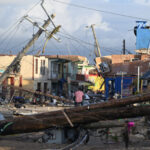Recent earthquakes in Colorado and elsewhere were induced by a drilling procedure to dispose of wastewater, federal geologists planned to argue in a report announced Wednesday.
The Denver Post reported Tuesday that Colorado drilling regulators said more study is needed on the link between drilling waste disposal and the uptick in earthquakes. But, nevertheless, regulators in Colorado have started to look for seismic risk in permit reviews.
A report due this week at a gathering of the American Geophysical Union says an increase in earthquakes on the Raton Basin in Colorado, northern New Mexico and elsewhere is tied to disposal wells where oil and gas drilling wastewater is injected. Drilling companies use disposal wells to bury brine water and chemical waste that result from hydraulic fracturing, or fracking.
A 5.3-magnitude earthquake near Trinidad last year triggered minor rockslides, toppled chimneys and cracked walls. No one was hurt. The quake followed injection of 4.9 million cubic meters of wastewater.
And on Tuesday, a 3.9-magnitude earthquake was recorded about 20 miles west of Cokedale, near the New Mexico border. The temblor was reported by the National Earthquake Information Center in Golden, but no damage was immediately reported.
The wastewater report should prompt discussion of disposal wells, said U.S. Geological Survey scientist Justin Rubinstein, co-author of the report.
“This is a societal risk you need to be considering,” Rubinstein told The Post.
A USGS team based in Menlo Park, Calif., found that the quake in Colorado and a damaging 5.6-magnitude quake in Oklahoma both were induced by disposal of fracking waste underground.
From 1970 until 2001, five quakes of magnitude 3 or higher were recorded on the Raton Basin. Scientists counted 95 quakes of that magnitude between 2001 and 2011 and concluded that oil and gas operations caused the majority, if not all, of the quakes since 2001.
While the evidence is convincing that deep burial of drilling waste can trigger quakes, it also appears that few of the 40,000 disposal wells nationwide have done so, Rubinstein said.
“But I don’t think blowing this off is a good idea,” he said. “It’s a problem we need to understand. There’s been millions of dollars of damage. If you trigger bigger earthquakes, there’s a possibility of worse outcomes.”
Colorado’s Oil and Gas Conservation Commission, the body charged with simultaneously regulating and promoting the industry, asked state geologists last year to review all permits for new disposal wells to assess earthquake risk, Colorado Geologic Survey chief Vince Matthews said.
Of the 330 or so disposal wells, 35 have been analyzed. Geologists recommended that COGCC tell some operators that if any small quakes are detected, the operators should pay close attention and install additional seismic sensors, Matthews said.
State criteria include whether quakes have happened before near a well, fault lines in the area and the direction of cracks in rock.
The federal scientists may be jumping to conclusions, Matthews said.
“I don’t think they’re nuts. I just think it is premature,” he said. “We’re gathering data that is going to help us understand what is going on down there.”
The USGS study went through an internal administrative review before this week’s unveiling. No peer review has been done.
Federal scientists discovered that most quakes this past decade were located within three miles of active disposal wells. They noted that wells contained exceptionally large volumes of wastewater.
At the moment, we’re the only people who have done this work, and our evidence is pretty conclusive,” Rubinstein said.
A report last summer by the National Research Council concluded that fracking does not pose a high risk for triggering earthquakes large enough to feel.
In more than 90 years of monitoring, human activity has been shown to trigger only 154 quakes, most of them moderate or small, and only 60 of them in the United States. That’s compared with a global average of about 14,450 earthquakes of magnitude 4.0 or greater every year, said that report.
Most of those are caused by gas and oil drilling the conventional way, damming rivers, deep injections of wastewater and purposeful flooding. Only two worldwide instances of shaking -_ a magnitude 2.8 tremor in Oklahoma and a 2.3 magnitude shaking in England – can be attributed to hydraulic fracturing, a specific method of extracting gas by injection of fluids. Both were in 2011.
Was this article valuable?
Here are more articles you may enjoy.

 Typhoon Kalmaegi Kills 21 as It Pummels Central Philippines
Typhoon Kalmaegi Kills 21 as It Pummels Central Philippines  KCC Estimates Privately Insured Losses From Hurricane Melissa Will Hit $2.4 Billion
KCC Estimates Privately Insured Losses From Hurricane Melissa Will Hit $2.4 Billion  Weather Claims and Bad Faith in the Face of Climate Change
Weather Claims and Bad Faith in the Face of Climate Change  Hurricane Melissa Takes Aim at Bahamas After Battering Cuba
Hurricane Melissa Takes Aim at Bahamas After Battering Cuba 